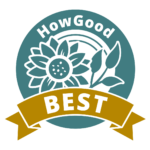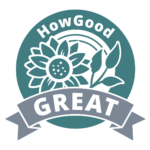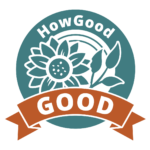HowGood is an independent research company and SaaS data platform with the world's largest database on food product sustainability. With more than 90,000 on-farm emissions factors for food ingredients, HowGood helps leading brands, retailers, suppliers and restaurants to measure, manage, and communicate their environmental and social impact.
Sustainability Ratings
Help consumers shop for the most sustainable products
HowGood’s Product Sustainability Ratings reflect a holistic assessment of the overall environmental and social sustainability of a product.

HOWGOOD
"BEST' RATING
This product has an environmental and social impact better than 95% of food products assessed by HowGood

HOWGOOD
"GREAT' RATING
This product has an environmental and social impact better than 85% of food products assessed by HowGood

HOWGOOD
"GOOD' RATING
This product has an environmental and social impact better than 75% of food products assessed by HowGood
How does HowGood measure sustainability?
- Greenhouse Gas Emissions: What is the carbon footprint (cradle-to-farm gate) of the ingredients in this product?
- Processing: How much energy is used to process the ingredients in this product?
- Blue Water Usage: How much “blue water” does it take to grow the ingredients in this product?
- Biodiversity: Does the growing of the ingredients in this product help or harm biodiversity?
- Soil Health: How does the growing of the ingredients in this product impact the soil?
- Land Use: How much land is required to produce the ingredients in this product?
- Animal Welfare: If relevant, how are the animals involved in the production of an ingredient treated?
- Labor Risk: What is the overall labor risk involved in the ingredients in this product, considering both the severity of the working conditions and the number of people affected?
These 8 metrics are evaluated on a spectrum from negative to positive impact. For some metrics, this illustrates impact from degenerative to regenerative. Products receive a score of 1-10 for each metric.

HowGood Impact Score
A product’s individual metric scores are consolidated to produce an overall product impact score. Each of the 8 sustainability metrics are weighted equally to yield a HowGood Impact Score out of 100. The HowGood Impact score gives a comprehensive view of the impact of a product.
How does HowGood rate products?
HowGood rates products on their environmental and social impact, also taking into account whether we would recommend the product. Our rating methodology is rooted in our understanding of the food system and experience rating food products on environmental and social performance for over 15 years.
Product ratings are based on the HowGood Impact Score (a measure of a product’s impact across 8 core sustainability metrics), and the following factors:
- Processing: Considers whether a product contains ingredients that are heavily processed.
- Labor conditions: Considers labor issues associated with sourcing locations and whether a product has a fair trade certification.
- # of ingredients: Considers the number of ingredients in a product.
- Organic: Considers whether a product has an organic certification.
Why do ratings take into account these additional factors?
While the HowGood Impact score is an assessment of a product’s overall sustainability, there are some considerations which it cannot address. The HowGood impact score is a quantitative reflection of a product’s on-farm practices and processing, which is largely conclusive. However, when translating impact into ratings, we also incorporate a qualitative assessment. Because ratings are meant to inform consumers, a more encompassing assessment is vital to effectively guiding sustainable purchasing decisions.
While the HowGood Impact score is an assessment of a product’s overall sustainability, there are some considerations which it cannot address. The HowGood impact score is a quantitative reflection of a product’s on-farm practices and processing, which is largely conclusive. However, when translating impact into ratings, we also incorporate a qualitative assessment. Because ratings are meant to inform consumers, a more encompassing assessment is vital to effectively guiding sustainable purchasing decisions.
Processing is a good example of a factor that is not considered in its entirety within the HowGood Impact score. The processing metric that is considered within the HowGood impact score takes into account the amount of energy required to produce a product. It does not take into account the complexity of its ingredients and whether they rely on commercial or industrial processing. A product may earn a high HG Impact score (equivalent to a Best rating), yet receive a SMN or Good rating because it contains ingredients that require very high levels of processing.
Similarly, the metrics that contribute to the total HowGood Impact score take into account standards and certifications that products and/or ingredients have received. However, we know that organic and fair trade certifications in particular are substantial when evaluating overall social and environmental sustainability. Fair trade is an important indicator of the social conditions associated with growing the ingredients in a product. Likewise, organic is a significant indicator of environmental sustainability, especially in terms of its benefit of reducing pesticides and chemicals relative to conventional farming practices. As such, additional qualitative adjustments have been factored in for products that may or may not have these certifications.
What has been the process for testing the efficacy of HowGood's rating system?
HowGood applies its 15 years of experience rating food products to conduct a number of litmus tests to evaluate where various types of products fall within the rating system and assess the validity of these ratings. The rating system has been checked against entire lists of food products. It has also been used to evaluate products by companies that have sustainable sourcing and the resulting ratings validated.
General guidance & implications of HowGood's product ratings
- Fresh produce will achieve a HowGood “Best” or “Great” rating in most instances.
- Most meat products will receive a “Standards Not Met” rating due to the negative environmental impacts of raising conventional meat and poultry products. However, organic meat may achieve a HowGood “Good” rating (higher ratings are less likely).
- Most seafoods will achieve a HowGood “Good” rating or higher because they tend to have less severe environmental impacts than meat products.
- Eggs will typically achieve a HowGood “Good” rating because they are minimally processed and often locally or regionally sourced.
- Milk and other dairy products will typically achieve a HowGood “Good” or better rating only when standards like Organic Certification are applied.
How are Sustainability Ratings applied to products?
Products qualify for Product Sustainability Ratings if their adjusted HowGood impact score is better than the large majority of food products in the industry assessed by HowGood. The HowGood Rating System labels top-performing food products as “Best”, “Great”, and “Good”. By translating overall product impact into easy-to-digest ratings, consumers can quickly evaluate and make higher impact shopping decisions. Impact thresholds for the Ratings are determined based on HowGood’s assessment of over 1 million products in the food system.
What methodologies and data sources does HowGood use to assess sustainability?
HowGood employs industry-recognized methodologies and incorporates data and findings from over 600 accredited data sources and certifications.
- GHG Emissions
- Processing
- Blue Water Usage
- Land Use
- Soil Health
- Labor Risk Exposure
- Biodiversity
- Animal Welfare
- GHG Protocol; IPCC GWP100a 2013
- GHG Protocol; IPCC GWP100a 2013
- Global Water Footprint Standard 2011
- ReCiPe 2016
- Bioversity International ABDI 2019
- UNGP Human Rights Risk Reporting Framework [SHIFT] 2015
- Bioversity Intl & HowGood Standard 2020
- Global Animal Partnership Standard 2020
What is HowGood’s research methodology?
HowGood has 15 years of research on global food supply chains. The team consolidates and analyzes findings from over 600 accredited data sources and certifications. These include a range of resources such as international frameworks, NGO guidance and standards reports, peer reviewed life cycle assessment studies, journal articles, academic conference proceedings and texts, aggregated commercial databases, targeted industry studies, NGO research, government publications, and news reports from reputable outlets. HowGood employs the most industry-recognized methodologies and incorporates the latest scientific research. Metrics and impact assessments are updated on an ongoing, iterative basis, making HowGood’s platform the leading-edge tool for product sustainability. In turn, HowGood is able to provide impact assessments that are accurate, comprehensive, and the most up-to-date. Through HowGood’s sustainability intelligence platform, Latis, we are able to scale this approach across products, brands, and the entire food industry.

HowGood
10 Gagnon Dr.
Stone Ridge
NY 12484
© 2024 HowGood.



